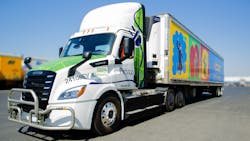Loblaw rolls out first battery-electric truck
Canadian grocery retailer Loblaw Companies recently rolled out its first fully electric, heavy duty transport truck as part of its “net-zero” carbon emissions strategy.
The vehicle is a battery-electric Freightliner eCascadia manufactured by Daimler Truck North America (DTNA). It’s the first series production eCascadia delivered to a customer in Canada, and one of five Loblaw expects to put into service in the months ahead, the company said. In 2017, Loblaw pledged that by 2030 it would decarbonize its fleet of more than 160 company-owned daycabs.
The truck will make daily runs between Loblaw’s distribution center in Boucherville, Quebec, and Loblaw stores in the Greater Montreal area, which includes Provigo, Provigo Le Marche, and Maxi. The trucks are expected to achieve up to 370 kilometers (230 miles) per charge while hauling up to 82,000 pounds of gradually diminishing gross weight, the company said. They will return to the Boucherville distribution center’s new charging station to recharge daily.
“It’s no secret that vehicle decarbonization is central to lowering greenhouse gas emissions, and we want to lead in the adoption of this new technology,” Brian Springer, vice president of national transport operations, said in a news release. “For nearly two years, we’ve piloted different vehicles across various parts of our business, and we’re excited to roll out a solution that works.”
The deployment of electric trucks is one of more than 250 projects Loblaw completed in the last year to help it achieve net-zero carbon emissions.
“Retailers like Loblaw have big ambitions to decarbonize the thousands of trucks that transport the food Canadians grow and consume every day,” said David Carson, DTNA SVP of sales and marketing. “This first battery-electric Cascadia in the hands of a Canadian customer marks an important milestone to move the industry toward a more sustainable, safe, and efficient future.
“The vision we share and leadership in our respective industries is helping to pave the way to carbon neutrality and an unprecedented transformation.”
Freightliner’s eCascadia is well suited for short-haul routes that allow for depot-based charging. With time being of the essence in this industry, a maximum battery capacity of almost 440 kWh can recharge 80% of the truck in approximately 90 minutes, the company said. To increase safety for traffic participants, especially in urban environments, the 82,000-lb., gross-combined-weight Class 8 truck comes standard with Detroit Assurance with Active Brake Assist 5 and debuts the Active Side Guard Assist, an industry-first technology that engages at urban speeds (20 kmph, or 12.4 mph, or less) to mitigate the truck from making a right turn when a moving cyclist or pedestrian is detected on the passenger side of the truck.
